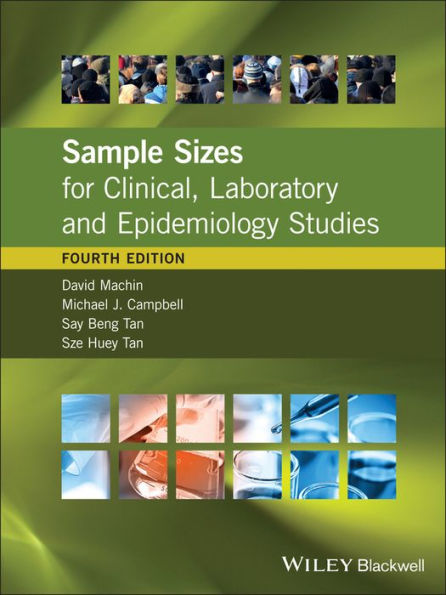Table of Contents
Preface viii
1 Basic design considerations 1
2 Distributions and confidence intervals 14
Table 2.1 The Normal distribution function-probability that a Normally distributed variable is less than z 27
Table 2.2 Percentage points of the Normal distribution for [alpha] and 1 - [beta] 28
Table 2.3 Values of [theta]([alpha],[beta]) = (z[subscript 1-alpha/2] + z[subscript 1-beta])[superscript 2] 28
Table 2.4 The t-distribution 29
3 Comparing two independent groups for binary data 30
Table 3.1 Sample size for the comparison of two proportions 38
Table 3.2 Sample size for the comparison of two proportions using the odds ratio (OR) 40
4 Comparing two independent groups for ordered categorical data 42
5 Comparing two independent groups for continuous data 47
Table 5.1 Sample sizes for the two sample t-test with two-sided [alpha] = 0.05 54
Table 5.2 Sample sizes for the two sample t-test with unequal variances 55
Table 5.3 Sample sizes for the one sample t-test with two-sided [alpha] = 0.05 57
6 Cluster designs, repeated measures data and more than two groups 58
Table 6.1 Multiplying factor for repeated measures designs 66
7 Comparing paired groups for binary, ordered categorical and continuous outcomes 67
Table 7.1 Sample sizes for paired binary data 82
Table 7.2 Sample sizes for paired continuous data with two-sided [alpha] = 0.05 83
8 Comparing survival curves 84
Table 8.1 Number of critical events for comparison of survival rates (Logrank test) 97
Table 8.2 Number of subjects for comparison of survival rates (Logrank test) 99
Table 8.3 Number of critical events for comparison of two exponential survival distributions with two-sided [alpha] = 0.05101
9 Equivalence 102
Table 9.1 Sample sizes for bioequivalence studies-difference between two means or ratio of two means 117
Table 9.2 Sample sizes for testing the equivalence of two means 118
Table 9.3 Sample sizes for testing the equivalence of two proportions 120
10 Confidence intervals 122
Table 10.1 Sample sizes required to observe a given confidence interval width for a given proportion in a sample from a large population 136
Table 10.2 Sample sizes required to observe a given confidence interval width for the difference between two proportions-independent groups 137
Table 10.3 Sample sizes required to observe a proportionate confidence interval width for the difference between two groups expressed via the odds ratio (OR) 138
Table 10.4 Sample sizes required to observe a given confidence interval width for the difference between two proportions from paired or matched groups 139
Table 10.5 Sample sizes required to observe a given confidence interval width to estimate a single mean or the difference between two means for independent or matched groups 141
11 Post-marketing surveillance 142
Table 11.1 Sample sizes required to observe a total of a adverse reactions with a given probability 1 - [belta] and anticipated incidence [lambda] 149
Table 11.2 Sample sizes required for detection of a specific adverse reaction with background incidence, [lambda subscript 0], known 150
Table 11.3 Sample sizes required for detection of a specific adverse reaction with background incidence unknown 151
Table 11.4 Number of cases to be observed in a case-control study 152
12 The correlation coefficient 153
Table 12.1 Sample sizes for detecting a statistically significant correlation coefficient 157
13 Reference intervals and receiver operating curves 158
Table 13.1 Sample sizes in order to obtain a required reference interval-Normal distribution 169
Table 13.2 Sample sizes in order to obtain a required reference interval-non-Normal distribution 170
Table 13.3 Sample sizes required to observe a given sensitivity or specificity in diagnostic accuracy studies-single sample 171
Table 13.4 Sample sizes required to observe a given sensitivity or specificity in diagnostic accuracy studies-two sample unpaired design 173
Table 13.5 Sample sizes required to observe a given sensitivity or specificity in diagnostic accuracy studies-two sample matched paired design 175
Table 13.6 Sample sizes required to observe a given confidence interval width for receiver operating curves (ROC) 177
14 Observer agreement studies 179
Table 14.1 Sample sizes required to observe a given confidence interal to estimate the proportion of disagreements between two observers 189
Table 14.2 Sample sizes required to observe a given confidence interval to estimate the within observer variation 190
Table 14.3 Sample sizes required to observe a given confidence interval to minimise the number of subjects required to achieve the desired precision in the probability of their disagreement, [curly or open theta subscript Dis] 191
Table 14.4 Sample sizes required to observe a given confidence interval width for inter-observer agreement using Cohen's Kappa, [kappa] 192
Table 14.5 Sample sizes required to observe a given intra-class correlation, [rho], using the confidence interval approach 193
Table 14.6 Sample sizes required to observe a given intra-class correlation using the hypothesis testing approach with two-sided [alpha] = 0.05 194
15 Dose finding studies 195
16 Phase II trials 207
Table 16.1 Fleming-A'Hern single-stage Phase II design 225
Table 16.2 Gehan two-stage Phase II design-Stage 1 226
Table 16.3 Gehan two-stage Phase II design-Stage 2 227
Table 16.4 Simon Optimal and Minimax designs 228
Table 16.5 Bayesian single threshold design (STD) 229
Table 16.6 Bayesian dual threshold design (DTD) 230
Table 16.7 Case and Morgan EDA design with [alpha] = 0.05 231
Table 16.8 Case and Morgan ETSL design with [alpha] = 0.05 232
Table 16.9 Simon, Wittes and Ellenberg design 233
Table 16.10 Bryant and Day design 235
17 Sample size software [characters not reproducible] 237
Cumulative references 239
Author index 249
Subject index 253



